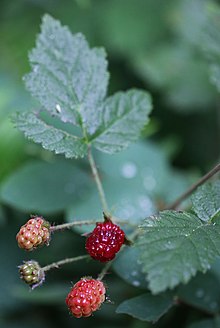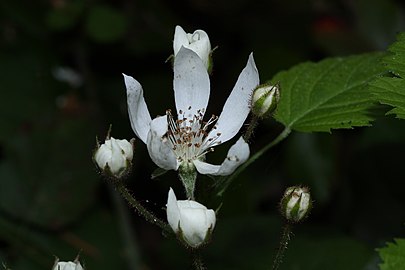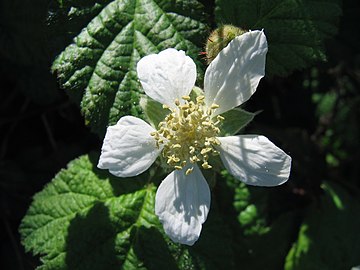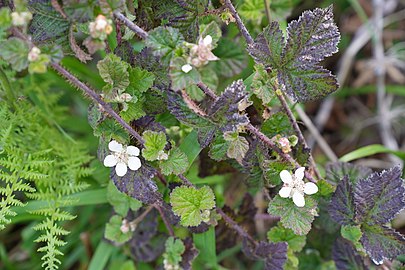Rubus ursinus
| Rubus ursinus | |
|---|---|

| |
| Maturing berries in the U.S. | |
| Scientific classification | |
| Kingdom: | Plantae |
| Clade: | Tracheophytes |
| Clade: | Angiosperms |
| Clade: | Eudicots |
| Clade: | Rosids |
| Order: | Rosales |
| Family: | Rosaceae |
| Genus: | Rubus |
| Subgenus: | Rubus subg. Rubus |
| Species: | R. ursinus
|
| Binomial name | |
| Rubus ursinus | |
| Synonyms[1][2] | |
Rubus ursinus is a North American species of blackberry or dewberry, known by the common names California blackberry, California dewberry, Douglas berry, Pacific blackberry, Pacific dewberry and trailing blackberry.
Description
[edit]Rubus ursinus is a wide, mounding shrub or vine, growing to 0.61–1.52 metres (2–5 feet) high, and more than 1.8 m (6 ft) wide.[3] The prickly branches can take root if they touch soil, thus enabling the plant to spread vegetatively and form larger clonal colonies.
The leaves usually have 3 leaflets but sometimes 5 or only 1, and are deciduous. The plant is dioecious, with male and female plants on separate plants, also unusual for the genus. As with other Rubus, the canes are typically vegetative the first year, and reproductive in the second.
The flowers are white with narrower petals than most related species, and have a fragrance.[4] The sweet, very aromatic, edible fruits are dark purple, dark red, or black and up to 2 centimetres (3⁄4 inch) in length.[5]
Taxonomy
[edit]Subspecies and varieties
[edit]Current or recent subspecies and varieties include:
- Rubus ursinus subsp. macropetalus — all of distribution range[6]
- Rubus ursinus subsp. ursinus — California and Oregon[7]
- Rubus ursinus var. sirbenus — endemic to California[8]
- Rubus ursinus var. ursinus — California and Oregon[9]
Cultivars
[edit]A cultivar of this species named the 'Aughinbaugh' blackberry was a parent of the loganberry. R. ursinus is also a second-generation parent of the boysenberry and the marionberry, or 'Marion' blackberry.[10]
'Wild Treasure' has the fruit size and flavor of the wild species, but without prickles, and the berries are machine harvestable. It was released by the U.S. Department of Agriculture's Agricultural Research Service in 2010, and is a hybrid between a selection of R. ursinus and 'Waldo' (another cultivar that is a second-generation descendant of the marionberry that has no prickles).
Etymology
[edit]The name is from rubus for "bramble" and ursinus for "bear".[10]
Distribution
[edit]The plant is native to western North America, found mainly in British Columbia (Canada); California, Idaho, Montana, Oregon, and Washington (Western U.S.); and Baja California state (Mexico).[11][12]
Cultivation
[edit]
The plant is cultivated for its fruit, and also ornamental plant qualities.[10][13] It is planted in home, native plant, and wildlife gardens, and in natural landscaping projects.[3][14] It can be espaliered or trained on fences and trellising.[10] When mature/established, the plant is effective in stabilizing creek banks and edges of bioswales.[13]
To set large fruit, the plant needs consistent amounts of moisture.[14] Otherwise it is moderately drought tolerant when established. Seed size seems to be related to fruit "cell" size, and the smallest fully formed berries (about 1 cm or 3⁄8 in) are most highly prized. These are sometimes called "little wild blackberries".
Uses
[edit]Diverse wildlife eat the berries, including songbirds, deer, bear, and other large and small mammals.[3] It is of notable pollinator and nesting material value for native bee and bumble bee species.[3] This blackberry species is a larval food source for Papilio rutulus (the western tiger swallowtail butterfly), Nymphalis antiopa (the mourning cloak butterfly), Strymon melinus (the gray hairstreak butterfly), and Celastrina ladon (the spring azure butterfly).[13]
Native Americans such as the Kumeyaay, Maidu, Pomo and Salish peoples used R. ursinus as a fresh and dried fruit source and as a traditional medicinal plant.[15] The Concow tribe calls this plant Gol-lē' in the Konkow language.[16]
Rubus ursinus crosses
[edit]| Red Antwerp Raspberry | Rubus ursinus Pacific Blackberry cultivar: Aughinbaugh | ||||||||||||||||||||||||||||||||||||||||
| Crandall Eastern Blackberry | Cuthbert Red Raspberry | ||||||||||||||||||||||||||||||||||||||||
| Rubus ursinus Pacific Blackberry | Loganberry | Black Logan | Phenomenal | ||||||||||||||||||||||||||||||||||||||
| Santiam | |||||||||||||||||||||||||||||||||||||||||
References
[edit]- ^ a b The Plant List, Rubus ursinus
- ^ "Rubus ursinus". Germplasm Resources Information Network. Agricultural Research Service, United States Department of Agriculture. Retrieved 22 December 2017.
- ^ a b c d Lady Bird Johnson Wildflower Center Native Plant Information Network−NPIN: Rubus ursinus (California blackberry, California dewberry, Western blackberry)
- ^ Ecoplexity.org: Rubus ursinus; description + images.
- ^ Flora of North America, Rubus ursinus Chamisso & Schlechtendal, 1827. California or Pacific or creeping blackberry
- ^ USDA: Rubus ursinus subsp. macropetalus
- ^ USDA: Rubus ursinus subsp. ursinus
- ^ USDA: Rubus ursinus var. sirbenus
- ^ USDA: Rubus ursinus var. ursinus
- ^ a b c d L.A. Weekly: "Rubus Ursinus, A Guide to the Elusive Pacific Blackberry"; published 15 March 2012; by Emily Green; accessed 9.9.2015.
- ^ Biota of North America Program 2014: Rubus ursinus by U.S. county distribution map
- ^ Calflora taxon report, University of California; Rubus ursinus Cham. & Schldl.; (California blackberry, Pacific blackberry)
- ^ a b c Las Pilitas Horticulture Database: Rubus ursinus
- ^ a b CNPS−California Native Plant Society.org: Rubus ursinus (California Blackberry−Pacific Blackberry)
- ^ University of Michigan at Dearborn: Native American Ethnobotany of Rubus ursinus
- ^ Chesnut, Victor King (1902). Plants used by the Indians of Mendocino County, California. Government Printing Office. p. 408. Retrieved 24 August 2012.
External links
[edit]- "Rubus ursinus". Calflora. Berkeley, California: The Calflora Database.
- Rubus ursinus in the CalPhotos photo database, University of California, Berkeley
- "Rubus ursinus". Plants for a Future.
- "Rubus macropetalus". Plants for a Future.
- Jepson Manual eFlora (TJM2) treatment of Rubus ursinus
- University of Washington, Burkey Museum herbarium image collection — photos, description, Washington distribution map.
- Northwest Oregon Wetland Plants Project, Rubus ursinus - Trailing blackberry; Dewberry; Pacific blackberry
- Rubus
- Berries
- Flora of California
- Flora of Baja California
- Flora of British Columbia
- Flora of the Northwestern United States
- Flora of the Cascade Range
- Flora of the Sierra Nevada (United States)
- Fruits originating in North America
- Plants used in Native American cuisine
- Plants used in traditional Native American medicine
- Plants described in 1827
- Natural history of the California chaparral and woodlands
- Natural history of the California Coast Ranges
- Natural history of the Central Valley (California)
- Natural history of the Channel Islands of California
- Natural history of the Peninsular Ranges
- Natural history of the San Francisco Bay Area
- Natural history of the Santa Monica Mountains
- Natural history of the Transverse Ranges
- Bird food plants
- Butterfly food plants
- Garden plants of North America







